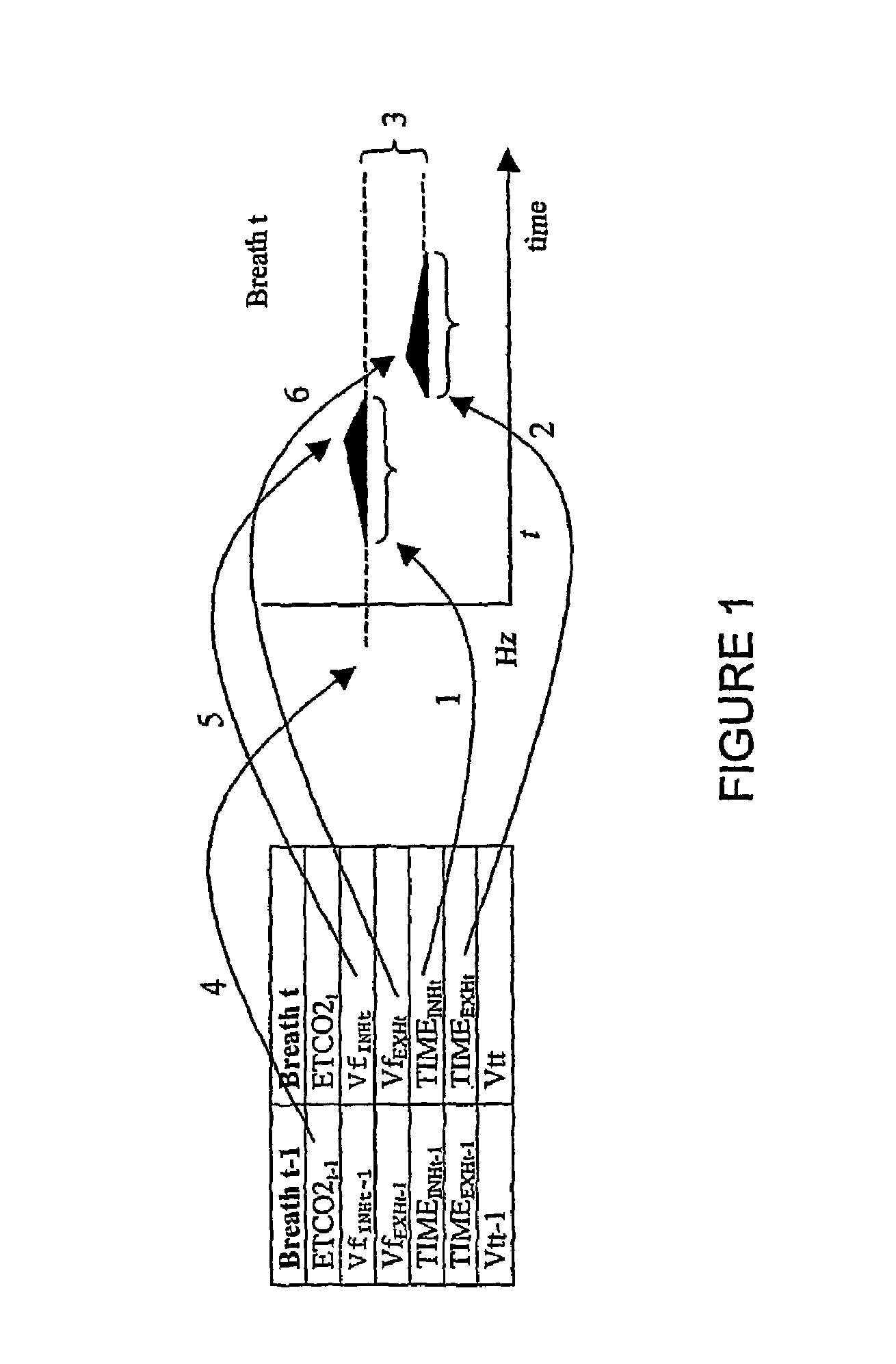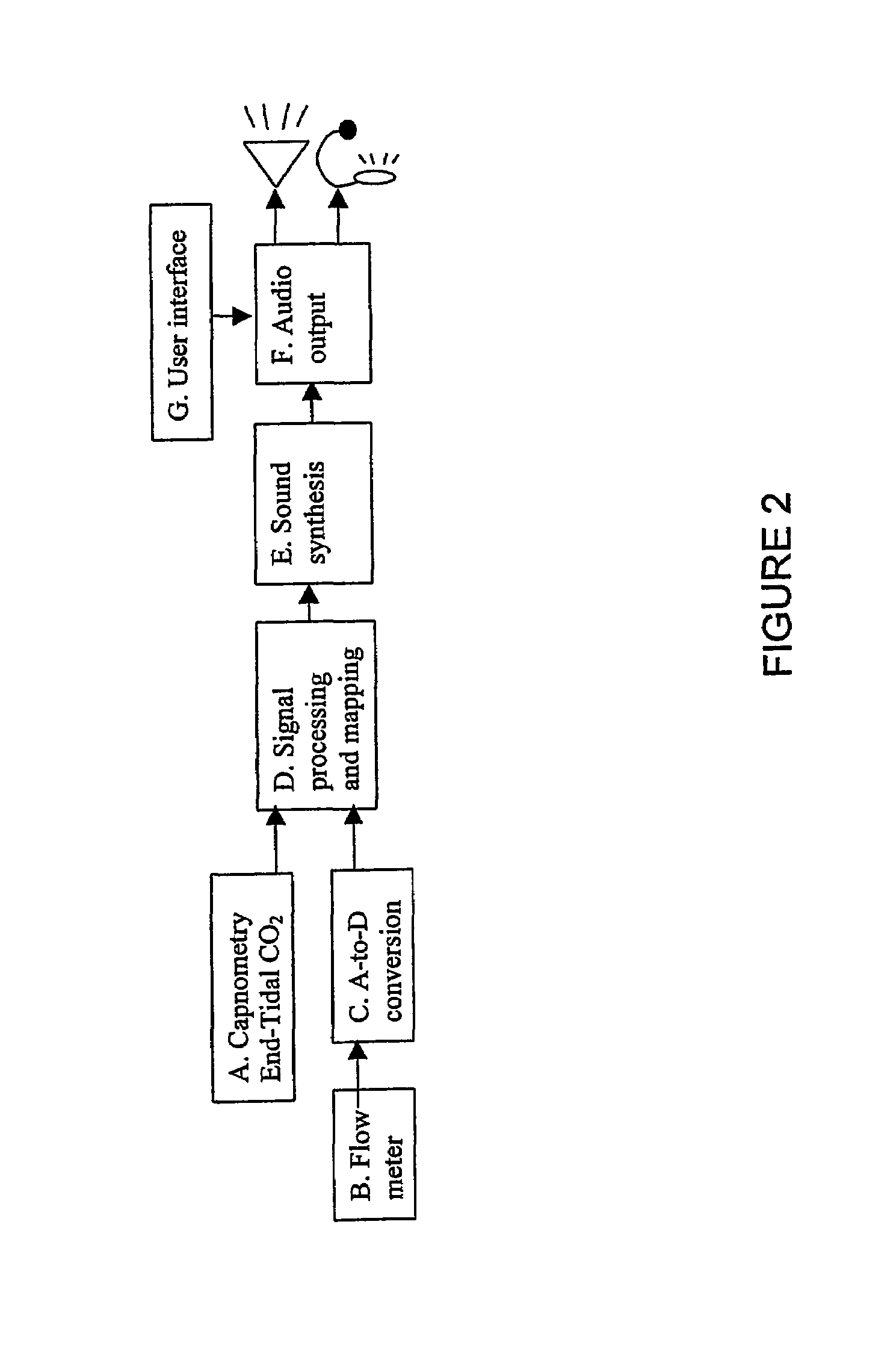Method and means of physiological monitoring using sonification
a physiological monitoring and sonification technology, applied in the field of methods and methods of human respiration and gas exchange monitoring, can solve the problems of inability to monitor, or distinguish between, different types of devices, and different limitations of devices
- Summary
- Abstract
- Description
- Claims
- Application Information
AI Technical Summary
Benefits of technology
Problems solved by technology
Method used
Image
Examples
example 1
Comparsion Various Methods of Respiratory Sonification
[0077]In comparing a preferred method of respiratory sonification with two older versions we made one hypothesis:
[0078]“At least one sonification of respiratory parameters will support judgements about respiratory status as effectively as pulse oximetry supports judgements about cardiovascular status.”
[0079]All sonifications used a pure tone and mapped inhalation and exhalation to the upper and lower note of a musical third. Respiration rate was represented by a direct temporal mapping of inhalation and exhalation. For the “Varying” sonification, CumVt was represented by sound intensity (but our proposed respiratory sonification also maps sound quality (timbre or brightness) into CumVt). The integration of volume flow over time gave tidal volume. ETCO2 was represented by a frequency modulation of the inhalation: exhalation minor third. Three variants were tested:
[0080](1). The Varying sonification worked as described above, mappi...
example 2
Relative Performance of Anaesthrtists
[0090]We used the Varying sonification to test the relative performance of anaesthetists (medically trained) and postgraduate students in information technology who had no physiology training. The Example used anaesthesia scenarios that led to a more even distribution of abnormal events across the five parameters, and also to a greater absolute number of abnormal events or directional changes to report. Our hypotheses were:
[0091]H2 If the Varying sonification presents physiological information in a way that is consistent with expert knowledge, then anaesthetists will perform better than non anaesthetists.
[0092]H3 Percentage correct responses for physiological parameters will be sensitive to the different overall event rates in Example 1 and Example 2.
[0093]H4 Percentage correct responses for different physiological parameters will be sensitive to the base rate probabilities of changes for different parameters.
[0094]Results of a between-within sub...
example 3
Monitoring Patient Status
[0102]In this example we examined participant's ability to use the respiratory sonification when performing other tasks. Monitoring was supported by sonification only, sonification plus a visual display, and a visual display only. The hypothesis was as follows:
[0103]H5 When participants perform a cognitively-loading primary task, they will be able to monitor patient physiological status more effectively when patient data is sonified than when it is visually supported.
[0104]To test this hypothesis we constructed a very conservative test. Participants performed a primary task in which they were required to make true / false judgements about simple arithmetic expressions (see FIG. 6) with a new expression occurring every 10 seconds. This had some similar characteristics to drug dosage calculations that a clinician might need to perform while monitoring patient status. At the same time, they performed the secondary physiological monitoring task, as in previous Exa...
PUM
 Login to View More
Login to View More Abstract
Description
Claims
Application Information
 Login to View More
Login to View More - R&D
- Intellectual Property
- Life Sciences
- Materials
- Tech Scout
- Unparalleled Data Quality
- Higher Quality Content
- 60% Fewer Hallucinations
Browse by: Latest US Patents, China's latest patents, Technical Efficacy Thesaurus, Application Domain, Technology Topic, Popular Technical Reports.
© 2025 PatSnap. All rights reserved.Legal|Privacy policy|Modern Slavery Act Transparency Statement|Sitemap|About US| Contact US: help@patsnap.com



